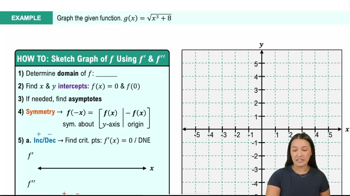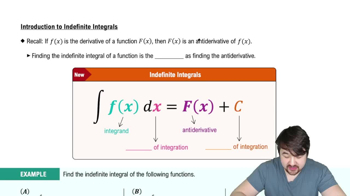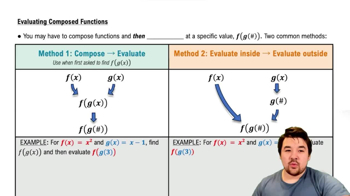Taxicab fees A taxicab ride costs $3.50 plus $2.50 per mile for the first 5 miles, with the rate dropping to $1.50 per mile after the fifth mile. Let m be the distance (in miles) from the airport to a hotel. Find and graph the piecewise linear function c(m) that represents the cost of taking a taxi from the airport to a hotel m miles away.
Table of contents
- 0. Functions7h 52m
- Introduction to Functions16m
- Piecewise Functions10m
- Properties of Functions9m
- Common Functions1h 8m
- Transformations5m
- Combining Functions27m
- Exponent rules32m
- Exponential Functions28m
- Logarithmic Functions24m
- Properties of Logarithms34m
- Exponential & Logarithmic Equations35m
- Introduction to Trigonometric Functions38m
- Graphs of Trigonometric Functions44m
- Trigonometric Identities47m
- Inverse Trigonometric Functions48m
- 1. Limits and Continuity2h 2m
- 2. Intro to Derivatives1h 33m
- 3. Techniques of Differentiation3h 18m
- 4. Applications of Derivatives2h 38m
- 5. Graphical Applications of Derivatives6h 2m
- 6. Derivatives of Inverse, Exponential, & Logarithmic Functions2h 37m
- 7. Antiderivatives & Indefinite Integrals1h 26m
- 8. Definite Integrals4h 44m
- 9. Graphical Applications of Integrals2h 27m
- 10. Physics Applications of Integrals 3h 16m
- 11. Integrals of Inverse, Exponential, & Logarithmic Functions2h 34m
- 12. Techniques of Integration7h 39m
- 13. Intro to Differential Equations2h 55m
- 14. Sequences & Series5h 36m
- 15. Power Series2h 19m
- 16. Parametric Equations & Polar Coordinates7h 58m
0. Functions
Piecewise Functions
Problem 49b
Textbook Question
Area functions Let A(x) be the area of the region bounded by the t -axis and the graph of y=ƒ(t) from t=0 to t=x. Consider the following functions and graphs.
b. Find A(6).
ƒ(t) =6 <IMAGE>
 Verified step by step guidance
Verified step by step guidance1
Step 1: Understand the problem. We need to find the area A(x) under the curve y = f(t) from t = 0 to t = x, where f(t) = 6.
Step 2: Set up the integral. Since A(x) is the area under the curve from t = 0 to t = x, we can express it as an integral: A(x) = \( \int_{0}^{x} f(t) \, dt \).
Step 3: Substitute the function into the integral. Since f(t) = 6, the integral becomes: A(x) = \( \int_{0}^{x} 6 \, dt \).
Step 4: Evaluate the integral. The integral of a constant 6 with respect to t is 6t. So, A(x) = \( [6t]_{0}^{x} \).
Step 5: Apply the limits of integration. Substitute the limits into the evaluated integral: A(x) = 6x - 6(0). Therefore, A(x) = 6x. To find A(6), substitute x = 6 into the expression: A(6) = 6(6).
 Verified video answer for a similar problem:
Verified video answer for a similar problem:This video solution was recommended by our tutors as helpful for the problem above
Video duration:
2mPlay a video:
Was this helpful?
Key Concepts
Here are the essential concepts you must grasp in order to answer the question correctly.
Area Under a Curve
The area under a curve in calculus represents the integral of a function over a specified interval. For a function y = f(t), the area A(x) from t = 0 to t = x is calculated using the definite integral ∫ from 0 to x of f(t) dt. This concept is fundamental in understanding how to compute the total area bounded by the curve and the axes.
Recommended video:

Summary of Curve Sketching Example 2
Definite Integral
A definite integral is a mathematical tool used to calculate the accumulation of quantities, such as area, over a specific interval. It is denoted as ∫ from a to b of f(t) dt, where a and b are the limits of integration. The result of a definite integral is a number that represents the net area between the function and the t-axis over the interval [a, b].
Recommended video:

Introduction to Indefinite Integrals
Function Evaluation
Function evaluation involves substituting a specific value into a function to determine its output. In the context of the problem, evaluating A(6) means calculating the area under the curve from t = 0 to t = 6 for the given function f(t). This process is essential for finding specific values related to the area function A(x).
Recommended video:

Evaluating Composed Functions
Related Videos
Related Practice
Textbook Question
109
views


